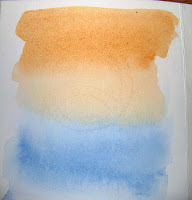First - tho' the book I was using as inspiration was small, approximately 4" x 4" and I thought that would be big enough, now I certainly wish I had an 8" x 8" book to work in (I would have to bind the edges with decorative tape or in some other manner, which could be cute and add another dimension of design)...or perhaps not even do a "meandering book", but just a straight forward art journal, such as the Amazing 16 page journal by Teesha Moore (part 1 here and part 2 here). Next journal will be an Amazing 16 page one!
Second - REMEMBER, when doing the meander book, to think through how the pages open and plan your pages in advance. I used a pencil to lightly mark page numbers in the lower corners help me remember the direction each would turn next.
Third - I am playing around with watercolors this year...I read - somewhere in all the free online tutorials I have found in searches - that you only need 3 colors, and you can mix what you need from those...but for myself, I am currently still borrowing from sweet tweener's school watercolors:
Prussian Blue
Burnt Sienna
Yellow Ochre
There is a crimson red that came with
the set that I have used in this project
when the Burnt Sienna doesn't give me
the color I want.
Fourth - I am approaching this more like a sketch book than a finished art product...so I am experimenting right in the little book. If you want yours to be more of a finished art piece, you might want to practice a scraps first, until you find the technique you want to use in each page.
Page One
I used a compass to lightly draw a circle to mark where I wanted to add water for a wet on wet technique, then I placed a "load" of each of my main three colors into the pre-wetted paper at 3 different points near the outer edge of the circle, then used the brush to guide the colors towards the center, letting them mingle freely as they chose. White space leaves the piece looking organic and light - the imperfection of it lending a natural look and helping to heal my need to be perfect! The imperfect is so inviting...in relationships as well as art...
But, there is something to be said for a little planning, as well. Especially when it comes to word placement. Again, using a light touch with a soft pencil lead, I sketched in the words around the outer edge of the circle, erasing and re-writing several times until the spacing of letters and white spaces fit...then I wrote over the top with my micron 01 pen. Finally I erased the pencil marks after waiting for the ink to dry a couple of minutes.
Here is a "wet on wet" tutorial I've watched and liked...
Page 2
Here I was trying to do a watercolor wash with one color, fading from darker to lighter with a mask over the trefoil I had transferred onto the page. I couldn't find my masking fluid (did sweet tweener borrow that?) Well, she couldn't find it either...so I improvised and painted some gel medium over the trefoil area so the watercolor would just wipe off. After the gel medium dried, I did the wash - the gradation isn't all that obvious, but it looks nice I think, just one color. I just used a paper towel wrapped around my finger to wipe away the color from the trefoil area. (I like Viva because it doesn't leave behind traces of paper). I also have started using up my soft knit recycle rags which also do not leave lint behind. I could still see - lightly - the lines from the tracing and they would no longer erase because of the gel medium, so I painted a light layer of white acrylic over the gel medium and that gave me the less defined look I wanted.
Page 3
I wanted to play more with blending the colors, so I painted each arc with one of my 3 main colors. Use your palette to add water to your color till you get it to a nice transparency. Then I painted the color straight onto the dry page. After I had laid all the colors down, I wet my brush more, and pulled the water around the points of where colors intersected to blend the transitions even more...when color went over the lines into the white area, I just added more water at that point and dabbed the wet color up with my lint free cloth...just experimenting with removing watercolor from the paper, too! I haven't decided how to add words to this page, or even if I want to - I like it in its simplicity right now.
Page 4
 Ahhhh fun! Wet the page with clean water, paint a strip of prussian blue along the bottom and with new clean wet brush, pull the color up towards the center...then paint a strip of burnt sienna along the top, clean and wet the brush again and pull the paint towards the center - don't touch the blue, let the colors move towards one another on their own and mingle...and the surprise was the yellowish result in the middle! I guess the blue didn't reach up very far, and the burnt sienna separated into the pigments that make it up...! I messed up the fish symbol a little - just couldn't find those light lines. I "saw" this classic Christian icon as I was working with the trequeta...and the implied two circles could represent heaven/God and the other earth/man...and their intersection the joining of the two through the experience of being "born again"...
Ahhhh fun! Wet the page with clean water, paint a strip of prussian blue along the bottom and with new clean wet brush, pull the color up towards the center...then paint a strip of burnt sienna along the top, clean and wet the brush again and pull the paint towards the center - don't touch the blue, let the colors move towards one another on their own and mingle...and the surprise was the yellowish result in the middle! I guess the blue didn't reach up very far, and the burnt sienna separated into the pigments that make it up...! I messed up the fish symbol a little - just couldn't find those light lines. I "saw" this classic Christian icon as I was working with the trequeta...and the implied two circles could represent heaven/God and the other earth/man...and their intersection the joining of the two through the experience of being "born again"... A little blurry, but you can see the entire page...
Template for 4 inch by 4 inch designs
8 inch by 10 inch circle
8 inch by 10 inch trefoil
8 inch by 10 inch trequeta
8 inch by 10 inch cross with circle











Post a Comment
0 comments: